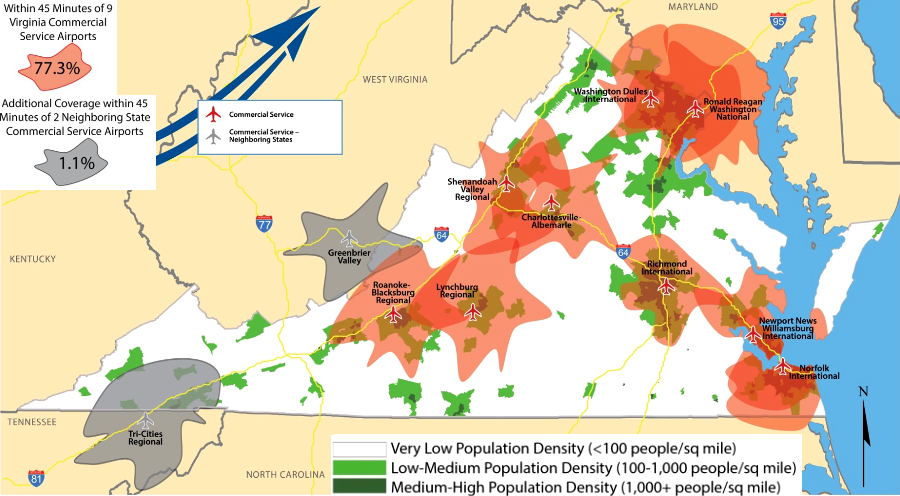
nearly 80% of Virginians live within a 45-minute drive of an airport offering scheduled passenger service
Source: Virginia Department of Aviation, Virginia Air Transportation System Plan Update (2016) (Figure 4-2)

nearly 80% of Virginians live within a 45-minute drive of an airport offering scheduled passenger service
Source: Virginia Department of Aviation, Virginia Air Transportation System Plan Update (2016) (Figure 4-2)
There are 66 airports open to public use in Virginia, plus military airports with restricted access. There are 57 general purpose airports that allow private and chartered use. The additional 9 airports in Virginia maintain Aircraft Rescue Fire Fighting (ARFF) teams and equipment, have terminals designed for Transportation Security Administration (TSA) checks and luggage processing, and arrangements with airlines which offer scheduled commercial passenger service:1
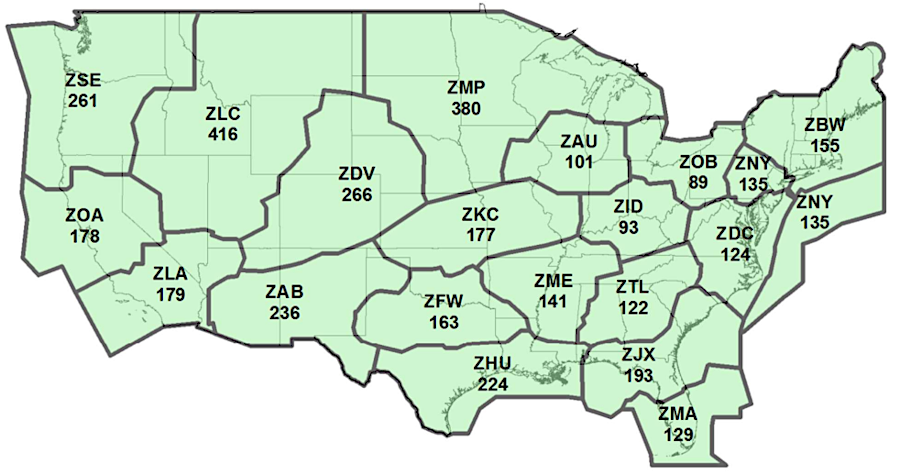
Virginia airspace is controlled by three of the 21 different Air Router Traffic Control Centers (ARTCCs)
Source: Federal Aviation Administration (FAA), Air Traffic By the Numbers (2022)
Three Virginia airports no longer offer scheduled passenger service: New River Valley Airport (PSK), Hot Springs/Ingalls Field (HSP), and Danville Regional Airport (DAN). In addition, Piedmont Airlines sought approval from the Civil Aeronautics Board in 1962 to offer scheduled passenger service to Shannon Airport (KEZF) at Fredericksburg, but that proposal was rejected. Hot Springs was the last Virginia airport to get scheduled passenger service, in 1964.
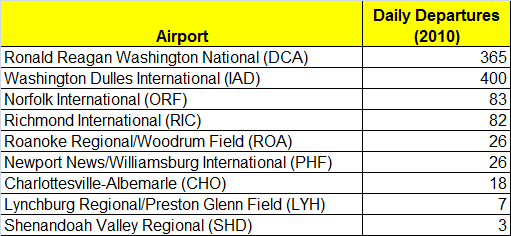
in 2010, there were over 1,000 takeoffs every day of a commercial airliner carrying passengers from nine Virginia airports - and 75% were from two airports in Northern Virginia
Source: Virginia Department of Aviation, Competitive Analysis of
Virginia's Aviation Industry (from Table 2.1)
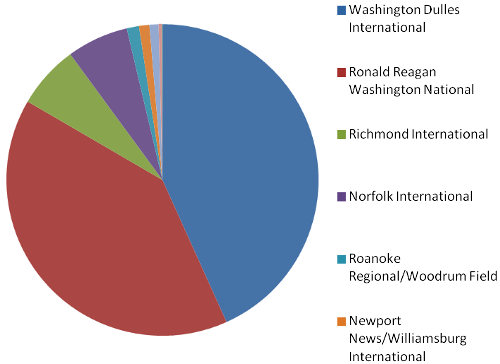
in 2013, over 80% of passengers using a Virginia airport got on board in Northern Virginia at Reagan National Airport (DCA) or Dulles International Airport (IAD)
Source: Federal Aviation Administration (FAA), Passenger Boarding (Enplanement) and All-Cargo Data for U.S. Airports
Only two of Virginia's airports now offering scheduled passenger service - Shenandoah Valley Regional Airport (SHD) and Roanoke-Blacksburg Regional Airport (ROA) - are west of the Blue Ridge.
Five of the nine airports - Dulles International Airport (IAD), Reagan National Airport (DCA), Richmond International Airport (RIC), Newport News/Williamsburg International Airport (PHF), and Norfolk International Airport (ORF) - are in Virginia's crescent-shaped population center, stretching from Northern Virginia through Richmond to Hampton Roads.
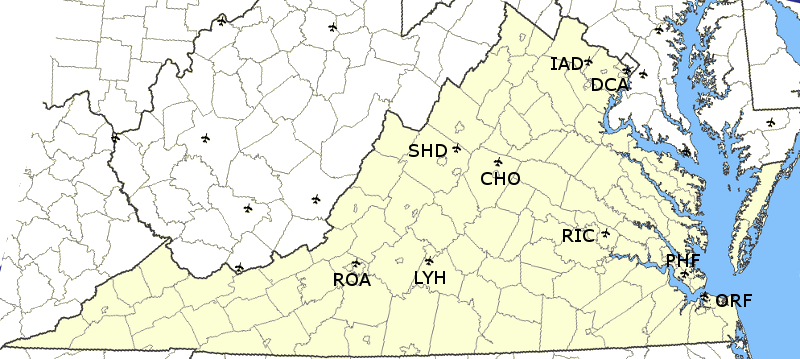
only two airports in Virginia offering scheduled commercial passenger service, Roanoke-Blacksburg Regional Airport (ROA) and Shenandoah Valley Regional Airport (SHD), are located west of the Blue Ridge
Source: National Atlas
The first airport in the United States was Huffman Prairie Flying Field. Orville and Wilbur Wright created it in Dayton, Ohio in 1904 to test their initial flying craft, after their first successful flights at Kitty Hawk, North Carolina on December 17, 1903. In Virginia, the first flying field was at Fort Myer, a site used by Orville Wright to demonstrate aircraft to military officers in hopes of making a sale.
On September 9, 1908, Wright kept a plane in the air for over a minute on the first test flight. The second test flight that day, with Lt. Thomas Selfridge as a passenger, exceeded four minutes. It ended badly, however, and Lt. Selfridge became the first person to die in a crash of a powered airplane in the United States.2
The first municipal airport was proposed in 1919 at Atlantic City, New Jersey.
The Army Air Service lacked the funding after World War I to build military airports. It encouraged development of municipal airports, which started after the US Congress passed the Air Mail Act of 1925 and the Air Commerce Act of 1926. The Federal government supported aviation through contracts to carry the mail, but required local/state governments to build the airports.
Under President Hoover, the philosophy was that airports were comparable to docks and wharves at seaports. The Federal government would improve the shipping channels in rivers and harbors, but non-Federal funds were required to build the docks and loading facilities for cargo.
The first airport in Virginia to be licensed by the State Corporation Commission was the Hybla (Alexandria) Airport. The license was granted to Elvin Robertson in 1929, and planes used the facility until 1955. Today the site is a residential subdivision.3
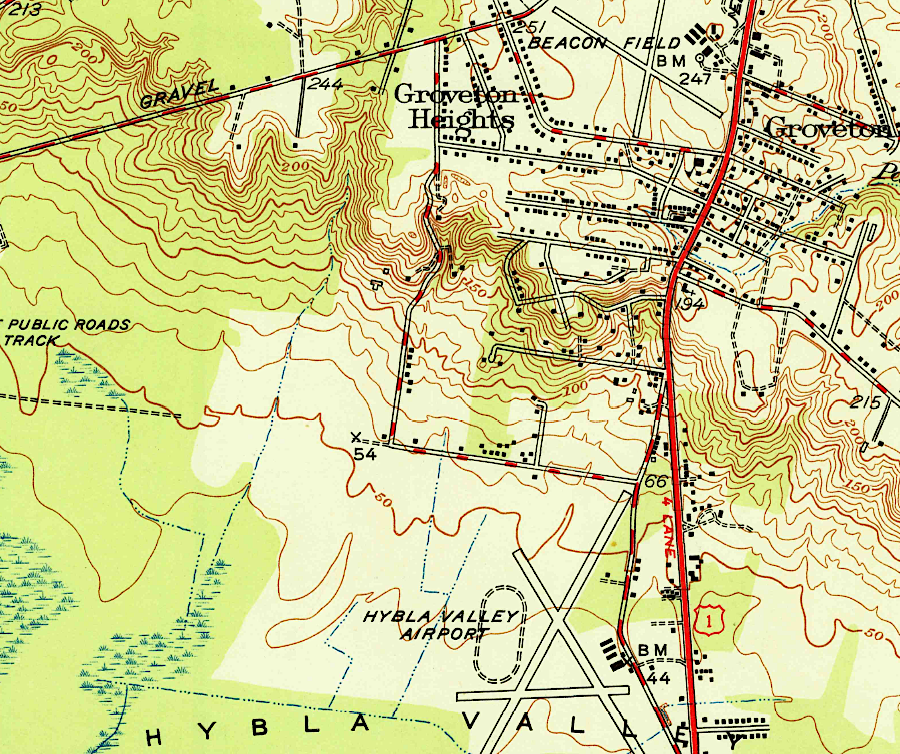
oin 1929, the Alexandria Airport/Hybla Valley Airport was the first in Virginia to be licensed
Source: US Geological Survey (USGS), Alexandria 1:24,000 topographical quadrangle (1951
On August 31, 1940, a Pennsylvania Central Airlines DC-3 crashed into farm fields near Lovettsville in Loudoun County during a storm. All 25 on board were killed, including US Senator Ernest Lundeen of Minnesota. At the time, it was the highest death toll of any airplane accident in the United States. Senator Lundeen was the second US Senator to die in a plane crash, after Senator Bronson Murray Cutting in 1935. That death triggered creation of the Civil Aeronautics Board in 1936.
Senator Lundeen was such a strong isolationist in 1940 that he was accused of being a Nazi sympathizer. When the plane crashed, he was flying to Minnesota to give a speech praising Adolph Hitler which a German agent had written. A paper copy of the speech was recovered at the crash site.
Reportedly the Federal Bureau of Investigation (FBI) was investigating him, and two agents on the plane were also killed in the crash. There were reports of a scuffle on the plane, and the cause of the crash was mysterious.
The first director of the Safety Bureau of the Civil Aviation Board was pressured to ground all DC-3's, which at the time carried about 90% of passengers on commercial flights. He determined that a lightning strike near the cockpit probably disabled or distracted the pilots, and the plane's design was not the cause of the accident. Assigning blame to lightning required assuming an "extraordinary lightning effect.."
According to the report:4
The airplane crash in Virginia which killed the largest number of people on a plane occurred n 1974. A TWA Boeing 727 slammed into Mount Weather near Upperville and killed all 92 passengers and crew.
In 1961, 77 people died when a chartered Lockheed Constellation carrying military recruits crashed near Byrd Field in Richmond. Two of the crew survived that crash, which was blamed on failure of the crew to transfer fuel as needed to keep the engines running. The 1982 crash of an Air Florida Boeing 737 at the 14th Street Bridge killed 78 people. Because the Potomac River at that site is part of Washington DC, the crash did not occur in Virginia.
The airplane crash that killed the most people in Virginia occurred on September 11, 2001. As part of the 9-11 attacks, five hijackers seized American Airlines Flight 77 after it had taken off from Dulles International Airport and flew it into the Pentagon. Including the hijackers, 64 people on the plane were killed immediately upon impact. In the Pentagon, another 125 people died from the impact and subsequent fire.5
Starting in the 1950's, Piedmont Airlines developed into the dominant local carrier in Virginia. At one time or another, it flew into every Virginia airport with scheduled commercial flights. The last addition to its schedule in Virginia was in 1966, when the Civil Aeronautics Board granted Piedmont Airlines authority to fly from Dulles International Airport (IAD).
Piedmont Airlines was incorporated into US Airways in 1989, which then merged with American Airlines in 2015. In 2016 American Airlines flew into eight of the nine Virginia airports with scheduled commercial flights. Piedmont Airlines had pulled out of Shenandoah Valley Regional Airport (SHD) in 1981, and it ended up as the only Virginia airport not serviced by American Airlines after the merger with US Airways. During the COVID-19 pandemic in 2020, American Airlines maintained service to Newport News/Williamsburg International Airport (PHF) when Delta suspended its flights there.6
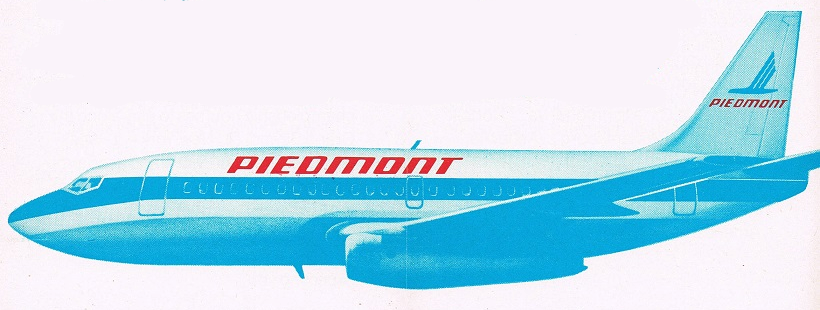
many travelers caught a Piedmont Airlines flight at a Virginia airport before the company was acquired by US Airways in 1989
Source: DepartedFlights.com, We're Brightening Our Look To Go With Our Outlook (1974)
Piedmont Airlines offered point-to-point flights, traveling short distances. As the hub-and-spoke pattern evolved, the airline advertised:7
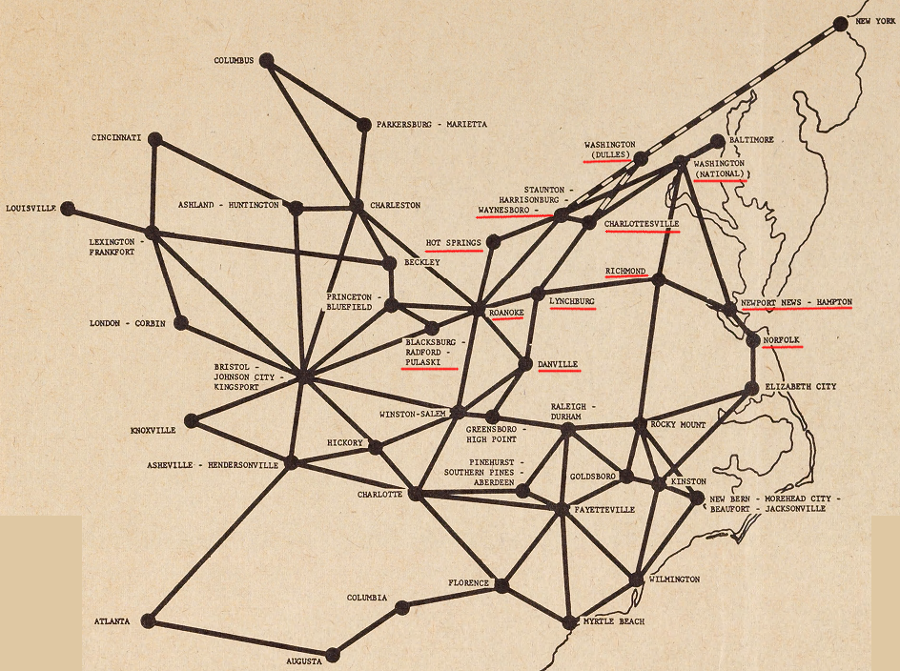
in 1966, Piedmont Airlines flew into every Virginia airport with scheduled passenger service
Source: North Carolina Digital Heritage Center, The Piedmonter (September, 1965)
Airports that offer scheduled commercial passenger service are clearly beneficial to economic development in a community. Such facilities draw customers from an area, a "hinterland," in the same way that port cities such as Alexandria established economic connections in the 1800's with rural areas that needed access to a seaport.
Virginia airports draw customers from other states, and Virginia residents can choose to drive to airports in other states. All nine of Virginia's airports offering scheduled passenger service are not-for-profit, publicly-owned facilities, but they operate like businesses and compete with each other.
The hinterland includes the primary catchment area from which most passengers come. Competition is more intense in the secondary catchment area, further from the airport terminal and closer to other airports.
The boundaries of catchment areas will vary for an airport, based upon the cost of different flights and the destinations. The catchment area for low-cost, short-distance flights extends far from the airport, to the point where the customers are located roughly halfway between two airports offering similar service. Customers are likely to choose "nearest airport" and be less willing to drive extra distances to a competing airport, when the potential savings in time/money are small.8
The catchment area for more-expensive flights is concentrated closer to the airport. If the inconvenience of driving the extra distance is offset by the savings in time or money, an airport can extend its catchment area.
For example, Northern Virginia residents who live close to Dulles (IAD) or Reagan National (DCA), but can save significant amounts of time/money by catching a Southwest flight from Baltimore-Washington International (BWI), may choose to drive the extra distance. Maryland residents may drive past BWI to catch an international flight from Dulles (IAD) that is more-direct and does not require a layover in an intermediate airport.
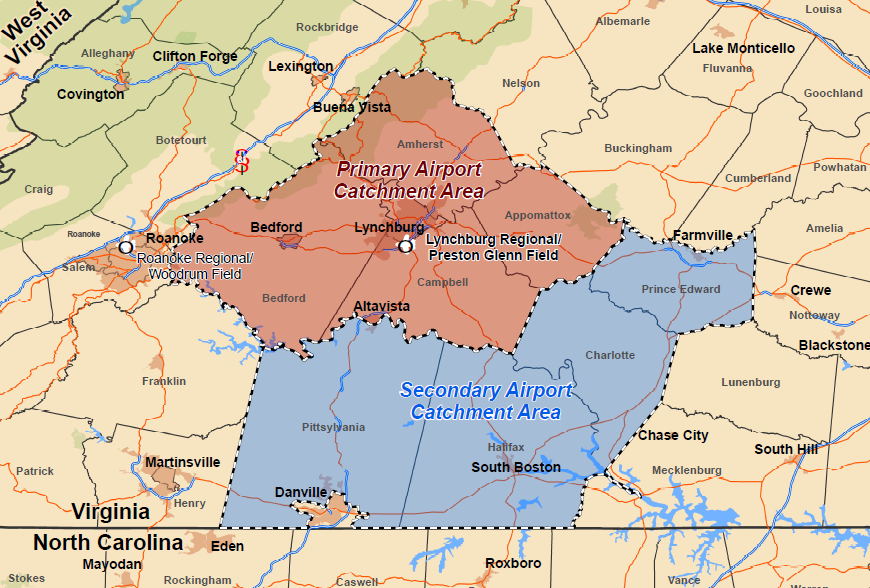
in the secondary catchment area, customers can choose to use a North Carolina airport unless service from Lynchburg Regional Airport (LYH) is more convenient or less expensive
Source: Lynchburg Regional Airport Master Plan Update (2010)
The number of passengers boarding an airplane (enplanements) or getting off (deplanements) at an airport reflects the population of the area, competition from nearby airports, and of course the desire of residents in that region to fly somewhere else. A large population base generates more traffic, so airports in urban areas attract more carriers. Competition results in flights scheduled more frequently and to more locations, and also lower costs.
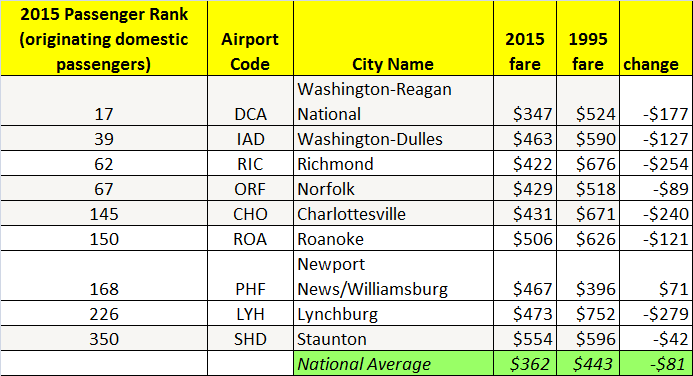
except for Staunton and Newport News-Williamsburg, average fares for flights from Virginia airports dropped more than national average between 1995-2015 (adjusted for constant 2015 dollars)
Source: US Department of Transportation - Bureau of Transportation Statistics, Average Domestic Airline Itinerary Fares By Origin City
With the hub-and-spoke scheduling pattern of airlines, fights from smaller airports feed passengers into larger airports that offer non-stop flights to more destinations. Richmond and Charlottesville residents can not catch a direct flight to the West Coast, or to Europe, from Charlottesville Albemarle Airport (CHO) or Richmond International Airport (RIC).
About 60% of scheduled departures from Virginia's airports are operated by regional jet equipment. Airlines pay lower wages to pilots flying smaller planes, such as those produced by Bombardier and Embraer, rather than larger aircraft with more than 50 seats. Many of those small jets connected to a hub outside Virginia, rather than feed passengers starting at a Virginia airport into the two major hubs in Northern Virginia:9
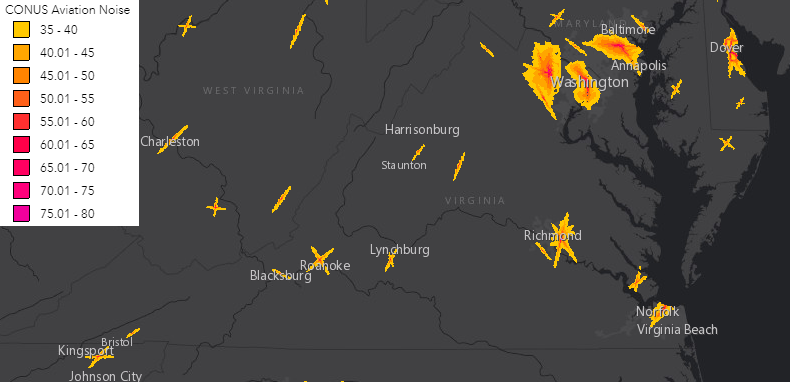
airplane noise patterns (measured in "weighted" decibels) reflect the orientation of runways at the state's major airports
Source: US Department of Transportation Geospatial Applications, National Transportation Noise Map
Areas with smaller populations generate fewer customers, and thus lower profits. An airline typically will charge higher fares at smaller airports, so the limited number of passengers will cover the fixed costs to provide service and will generate a rate of return on the airline's investment comparable to flying to airports with many customers.
In response to high fares and a limited selection of destinations at small airports, travelers will drive several hours to reach a different airport with greater competition and better service. Airports near the border of Virginia in Maryland, Tennessee, and North Carolina compete with the nine Virginia airports that offer scheduled commercial passenger service.
Service from Shenandoah Valley Regional Airport (SHD) is limited, and the drive to airports in Richmond and Northern Virginia can take less time than the flight plus delays in making connections. In 2009, the airport reported that over 90% of its local market was choosing to use other airports in the region rather than catch the connecting flights offered at the time by United Express to Dulles International Airport.10
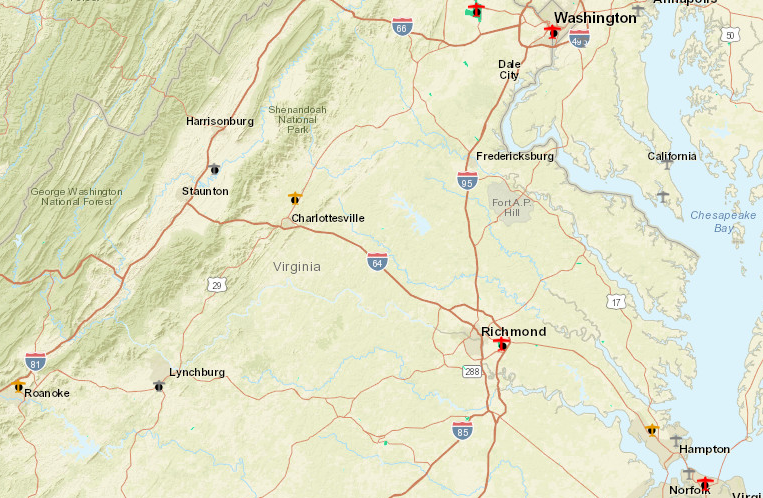
travelers in the Shenandoah Valley take interstate highways to fly out of Dulles International Airport (IAD) or Richmond International Airport (RIC)
Source: ESRI, ArcGIS Online
Dulles International Airport (IAD) and Reagan National Airport (DCA) pull passengers from the Richmond and Charlottesville area as well as the Shenandoah Valley. The headaches of parking and passing through airport security is such a deterrent that some customers from Central Virginia drive directly to Northern Virginia airports, eliminating the "hop" from the smaller airport. That may require more time in traffic on Route 29 or I-95, but can eliminate the potential of a missed connection as well as reduce overall time and costs for a long trip.
Baltimore-Washington Airport (BWI) draws Northern Virginians across the Potomac River, in part due to the many low-cost flights scheduled by Southwest Airlines. The airport provides driving directions for customers coming from as far south as Richmond, making clear that Baltimore-Washington Airport (BWI) views Central Virginia as part of its catchment area.
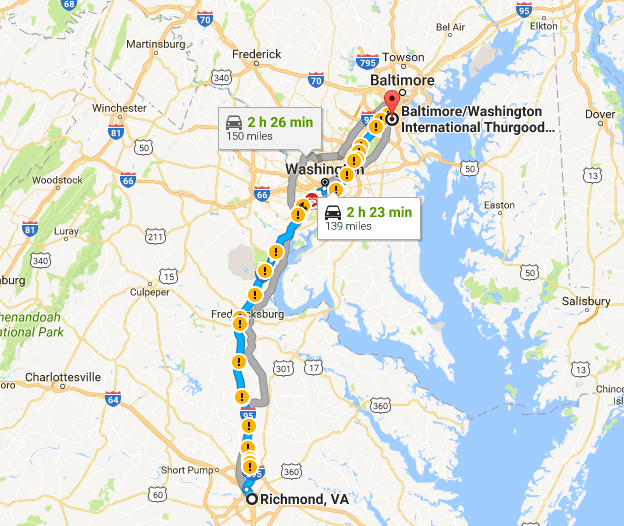
Baltimore-Washington Airport (BWI) provides driving directions for passengers who might come from Richmond, though the traffic on I-95 might deter customers
Source: Federal Aviation Administration (FAA), Google Maps
For many living in Southside Virginia, North Carolina airports in Greensboro, Raleigh, and Charlotte offered the most-convenient and lowest-cost commercial airline service to a wide range of destinations.
Potential airline passengers drive to out-of-state airports from the local "capture area" surrounding Virginia's nine airports with scheduled commercial service. Until Virginia's airports can offer cheaper flights and better schedules, "leakage" will continue to airports in Baltimore (MD), Lewisburg (WV), Blountville (TN), Charlotte (NC), Greensboro (NC), and Raleigh (NC).
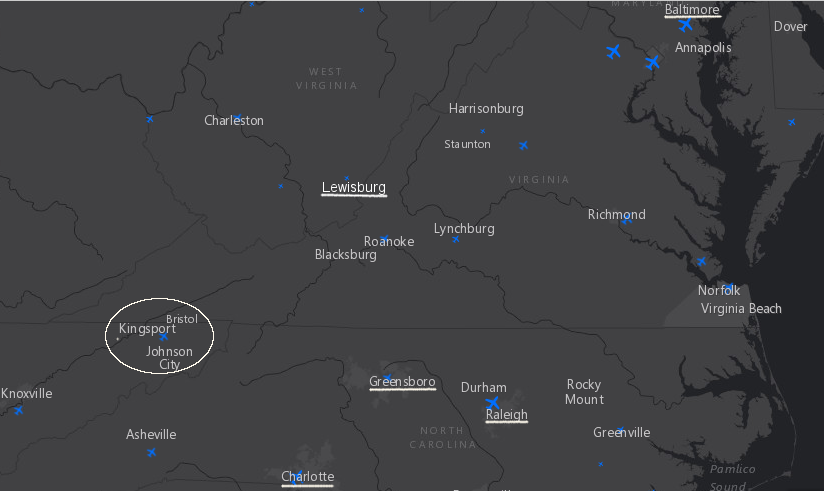
cheaper flights and better schedules generate "leakage" to airports in Maryland, North Carolina, and Tennessee
Source: ESRI, ArcGIS Online
The best option for some Southwestern Virginia residents is the Tri-Cities Airport (TRI). It is located in Blountville, Tennessee, near the "tri-cities" of Bristol, Kingsport, and Johnson City.
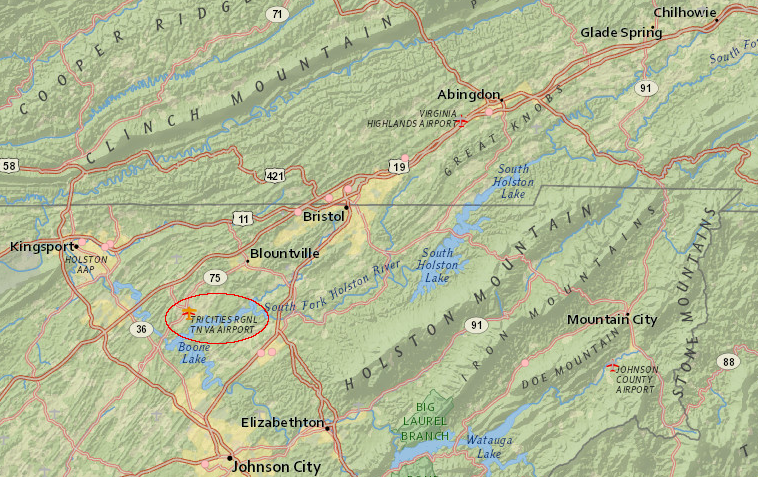
Tri-Cities Airport in Tennessee (which dropped "Regional" from its name in 2016) serves Southwestern Virginia
Source: ESRI, ArcGIS Online
 In 2016, Allegiant, American, and Delta Connection offered scheduled service from the Tennessee airport to Atlanta, Charlotte, Orlando, and Tampa-St. Petersburg. Bristol, Virginia has one voting member on the 12-person board that manages the airport; the other members represent jurisdictions in Tennessee.
In 2016, Allegiant, American, and Delta Connection offered scheduled service from the Tennessee airport to Atlanta, Charlotte, Orlando, and Tampa-St. Petersburg. Bristol, Virginia has one voting member on the 12-person board that manages the airport; the other members represent jurisdictions in Tennessee.
The airport dropped "Regional" from its name in 2016, part of a branding exercise to emphasize the "TRI" instead. Bristol sits on the border but is one of the three urbanized area in the Tri-Cities region, so its role was not diminished by the re-branding.11
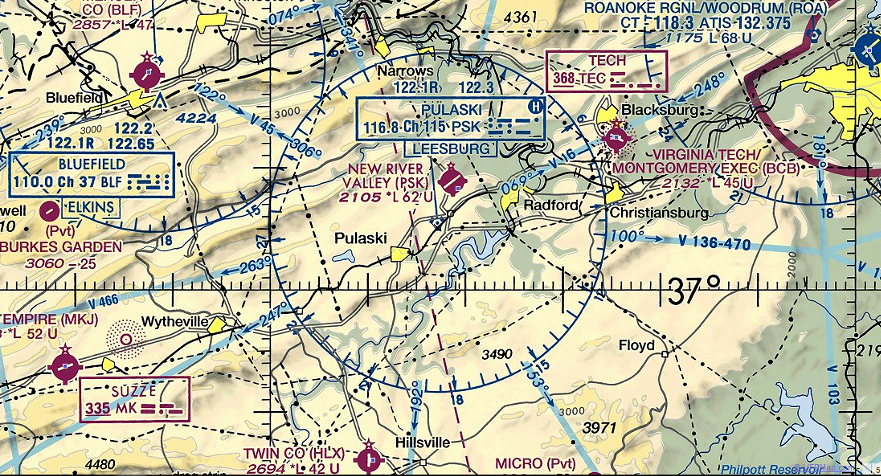
pilots traveling to Southwestern Virginia rely upon General Aviation airports west of Roanoke
VFR MAP
Most commercial passenger "enplanements" (passengers getting on board a plane to start a flight) occur at the two airports in Northern Virginia. Dulles International Airport (IAD) and Reagan National Airport (DCA) generated over 20 million boardings in 2015. Virginia's other seven with scheduled passenger service generated only 4 million boardings, combined.12
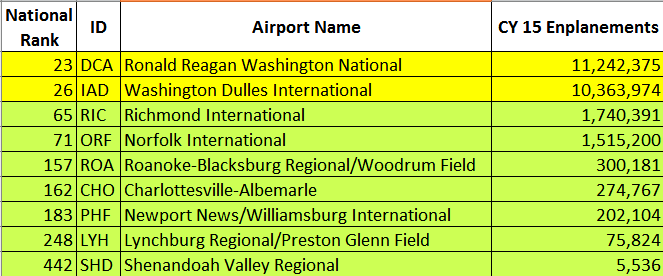
in 2015, 84% of commercial passengers using Virginia airports boarded (enplaned) at Dulles International Airport (IAD) and Reagan National Airport (DCA) in Northern Virginia
Source: Federal Aviation Administration (FAA), Passenger Boarding (Enplanement) and All-Cargo Data for U.S. Airports
The seven smallest airports in Virginia with scheduled passenger service used smaller airplanes than the two largest airports. As a result, they had 23% of the aircraft landings/take-offs even though those seven airports carried only 16% of the passengers in 2015.13
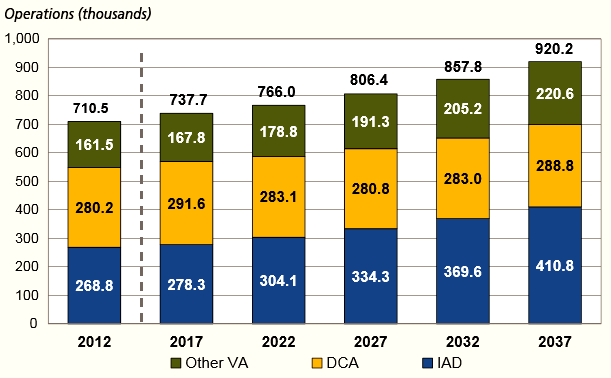
77% of scheduled passenger plane landings/take-offs in Virginia occur at Dulles International Airport (IAD) and Reagan National Airport (DCA)
Source: Virginia Air Transportation System Plan Update (2016), Executive Summary (p.4)
The number of travelers using Virginia airports declined between 2007-2013, as the airlines focused on servicing major hubs and reduced flights from smaller airports. Airlines exercised "capacity discipline" after the 2008 economic recession and limited expansion during the recovery, and squeezed more passengers into each flight. Scheduled domestic flights leaving from a Virginia airport dropped 12% during those years, and overall passenger traffic dropped by 5%.
Newport News/Williamsburg International Airport lost almost half of its traffic in 2012, when low-cost airline Air-Tran cancelled service and chose to fly instead out of Richmond and Norfolk. Efforts by the airport manager to recruit a replacement carrier, PeoplExpress, led to scandal with misuse of government funds.
Large amounts of money are involved in airport operations, as well as in contracts for capital improvements. Airport managers award contracts for a Fixed Based Operator (FBO) to provide fuel and other services to general aviation customers, and incumbent contractors with intimate familiarity with a particular airport are well-positioned to win renewals when airports re-compete. In 2020, the chief and the head planner at Roanoke-Blacksburg Regional Airport (ROA) were suspended and later resigned, and the incumbent Fixed Base Operator charged a former employee with leaking proprietary company data so the airport could increase competition for its next contract. The airport staff argued that the incumbent had an unfair advantage, and claimed their use of the data was appropriate because "it levels the playing field."14
Airlines have been quick to cancel flights that did not generate sufficient profit at a Virginia airport. Officials at Norfolk International Airport (ORF) convinced Southwest to offer three Norfolk-Atlanta flights, but they were dropped from the schedule in 2014 as the airline consolidated with AirTran and focused on using Boeing 737s.15
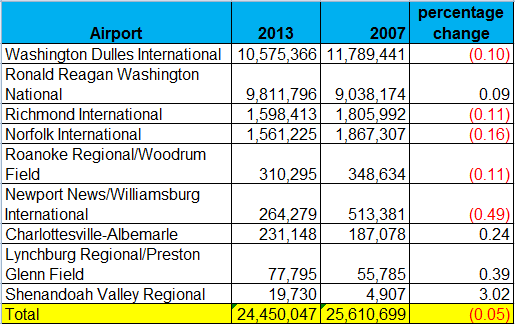
between 2007-13 - a time of major economic recession - passengers using Virginia airports declined by 5%
Source: Federal Aviation Administration (FAA), Passenger Boarding (Enplanement) and All-Cargo Data for U.S. Airports
The decline in air travel after the 2008 recession may have stabilized nationally, but in 2017 four of the airports in Virginia were still at risk of losing some existing service.
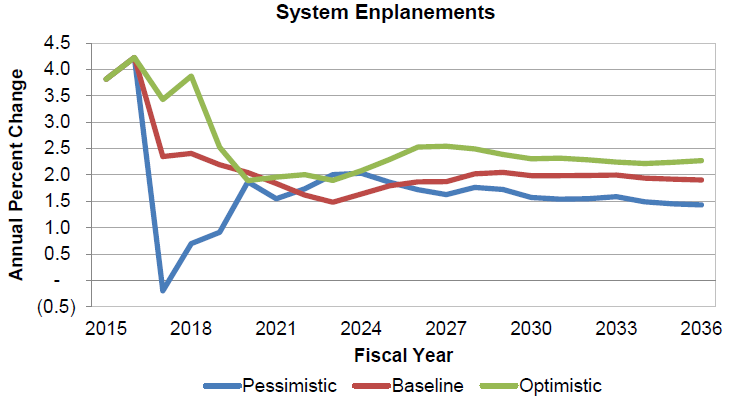
in 2016 the Federal Aviation Administration predicted future air travel would be steady despite past fluctuations due to changes in oil prices, international conflict, and economic recession/recovery
Source: Federal Aviation Administration, FAA Aerospace Forecast (2016-2036) (p.47)
The Roanoke-Blacksburg Regional Airport (ROA) and Lynchburg Regional Airport (LYH) would be affected if airlines adopted different jets designed for longer flight distances. Newport News/Williamsburg International Airport has been threatened by reduced income ever since Air-Tran left in 2012. Shenandoah Valley Regional Airport (SHD) has been able to maintain limited scheduled passenger service only through the Essential Air Service subsidy, a Federal program which Congress could alter at any time.
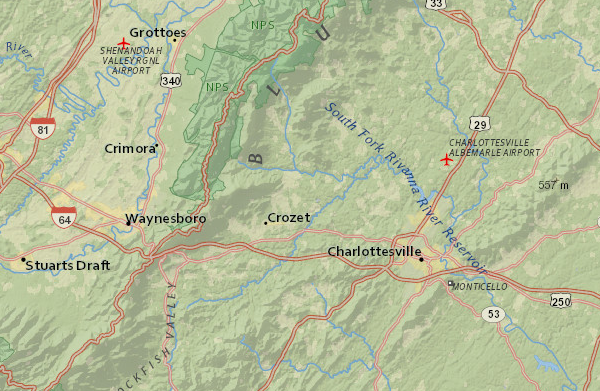
Shenandoah Valley Regional Airport (SHD) requires a Federal subsidy through the Essential Air Service program to retain scheduled commercial service
Source: ESRI, ArcGIS Online
Reduced competition due to consolidation of airlines, creation of the hub-and-spoke system, and introduction of new jets has caused carriers to drop service to small markets. Three Virginia airports have lost scheduled passenger service - New River Valley/Pulaski in 1972, Hot Springs in 1993, and Danville in 1995.

two of the six Virginia airports for which Essential Air Service determinations have been made (Hot Springs and Danville) no longer have scheduled passenger service
Source: US Department of Transportation, Essential Air Service Determinations
After Danville approved construction of the Caesars Virginia casino in 2021, it received the lion's share of construction grants awarded to 27 airports that year by the Virginia Department of Aviation. The state agency gave $1.1 million of the $6.4 million in that grant cycle to Danville, in anticipation of increased passenger traffic on private planes.16
In 2023, the City of Manassas received a proposal to initiate commercial airline service from the Manassas Regional Airport (HEF). That airport was already the largest general aviation airport in Virginia.
The proposal came from Avports, which already managed 11 other airports. Manassas was asked to lease the airport terminal and other parcels for 40 years. Avports would operate the passenger facilities (with 4-6 gates) and the commercial airliner parking area. The city would continue to manage the rest of the airport, including general aviation services.
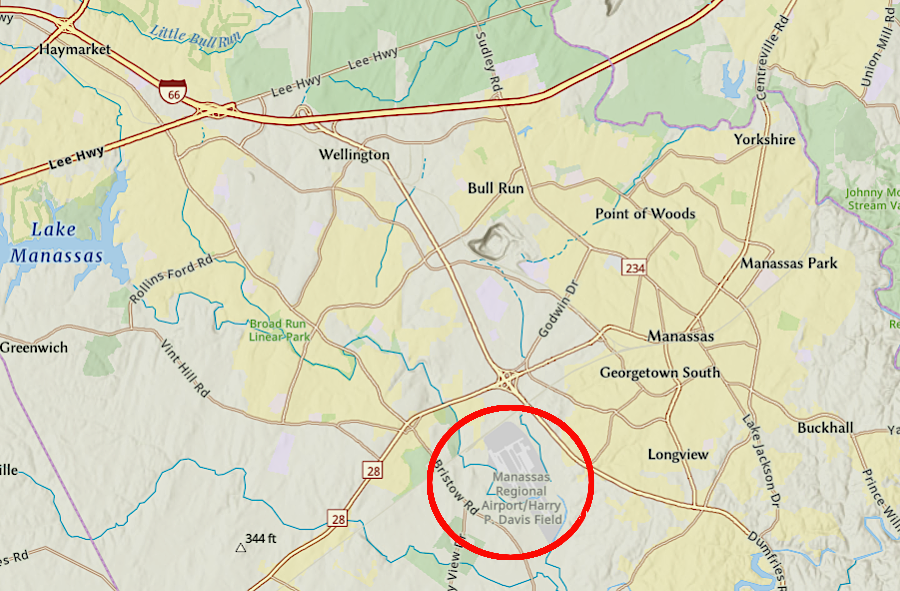
in 2023, Avports proposed that Manassas Regional Airport initiate commercial passenger air service
Source: ESRI, ArcGIS Online
Avports committed to obtain Part 139 certification from the Federal Aviation Administration (FAA) to allow commercial airline service. The expectation was that budget operators such as Spirit, JetBlue or Breeze would offer flights to Florida destinations.
Those airlines could be attracted to Manassas Regional Airport (HEF) because Avports would charge only $8-10 per passenger, compared to $15 per passenger for landing and other fees at Reagan National Airport (DCA) and Dulles International Airport (IAD). The Manassas Regional Airport already handled 100,000 flights per year for general aviation, and commercial passenger flights would add another 15,000 flights per year.
The 40-year lease from the city would cost nearly $30 million, and the Avports proposal involved major up-front investment costs:17
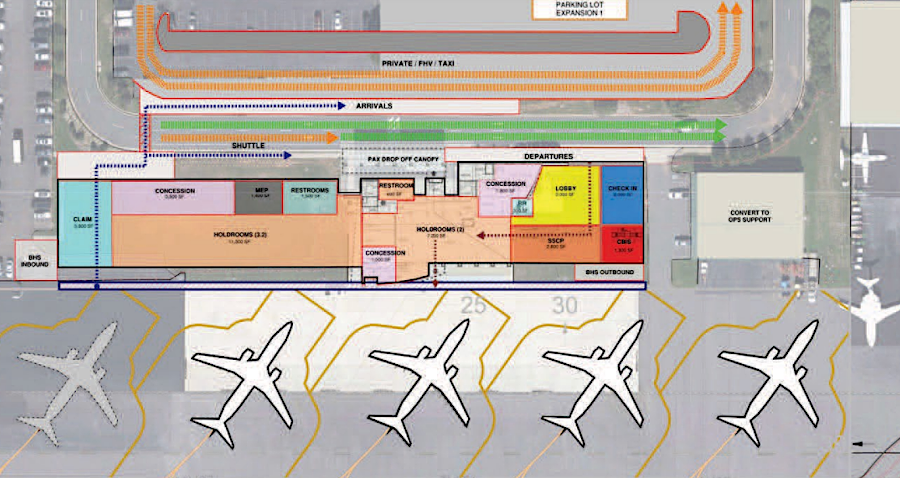
Avports proposed to expand the terminal and install 4-6 gates at Manassas Regional Airport
Source: Avports, Franchise Proposal for: Terminal Building Development & Ground Lease, for the Provision of Passenger Airline Services at the Manassas Regional
Airport
Virginia may be the state with the most overflights by scheduled commercial carriers, counting "flyover" trips that do not start or stop at a Virginia airport. Many of those flights involve trips between Hartsfield-Jackson Atlanta International Airport (ATL) and airports northeast of Virginia, but the largest number of overflights involve planes going between Toronto Pearson International Airport (YYZ) and Caribbean and South America destinations.18
Airplane engines rely upon aviation gas or jet fuel for power. Aircraft are likely to be the last form of transportation to convert from fossil fuels to a renewable energy source that does not increase greenhouse gas emissions, since the energy-to-weight ratio of fossil fuels is so high. Piston-engine aircraft still use leaded gasoline, and according to the Environmental Protection Agency:19
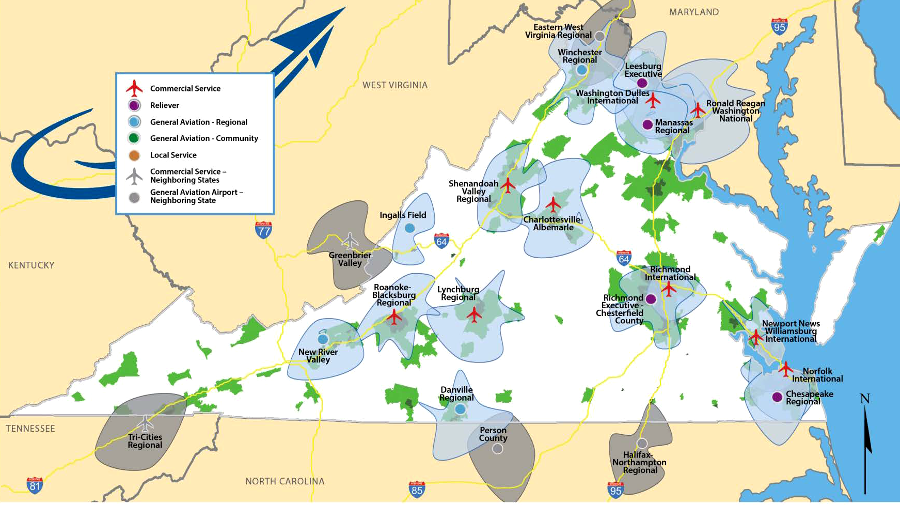
17 airports in Virginia had a runway length of 5,500 feet or greater in 2016
Source: Virginia Department of Aviation, Virginia Air Transportation System Plan Update (2016), Current Access to Airports with a Runway Length of 5,500 feet or Greater (Figure 4-4)
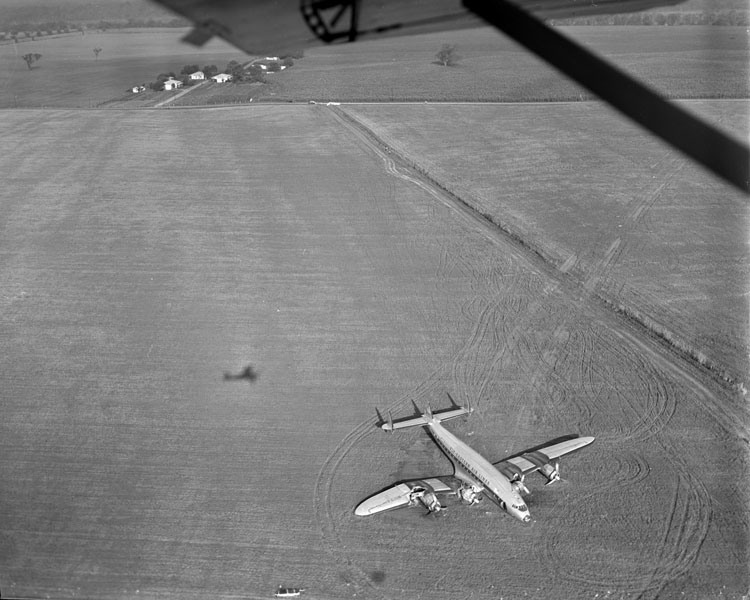
an Eastern Air Lines plane crash-landed at Curles Neck Farm in 1951, with no casualties
Source: Library of Virginia, Eastern Air Liner crash landing, Curles Neck Farm
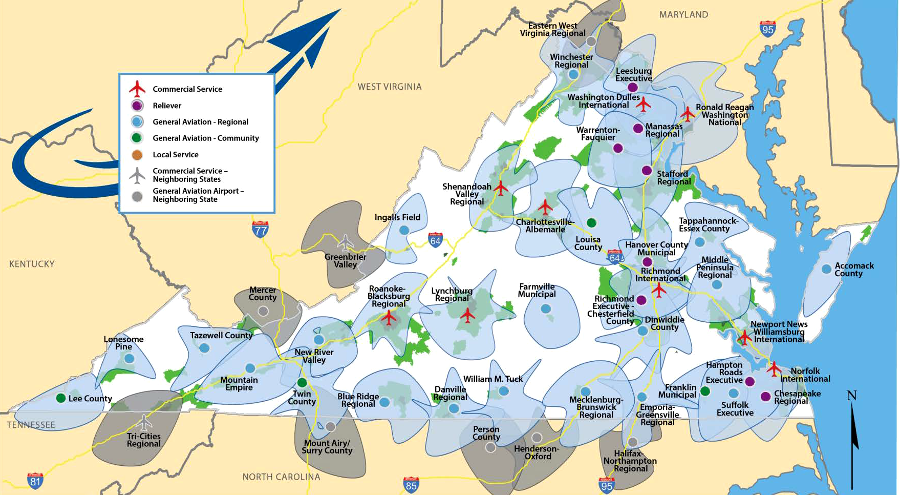
38 airports in Virginia had a precision approach supported by vertical guidance in 2016, making them attractive sites for executives flying in business-class airplanes
Source: Virginia Department of Aviation, Virginia Air Transportation System Plan Update (2016), Current Access to Airports with Precision Approach and LPV Guidance (Figure 4-4)
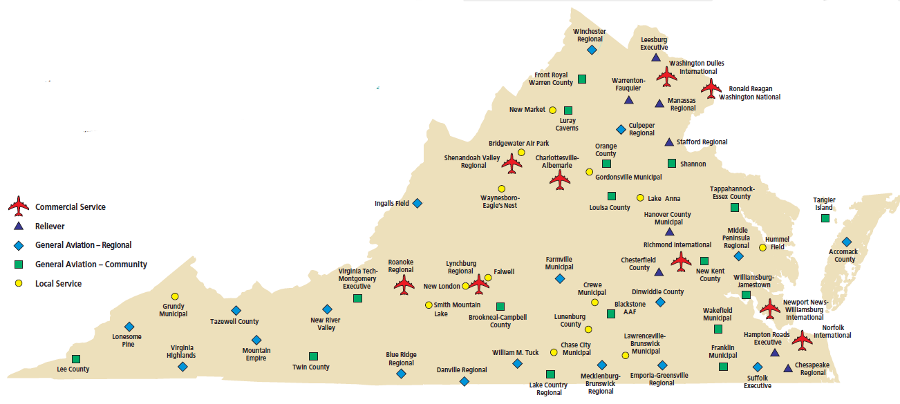
most airports in Virginia service General Aviation traffic, and only nine support scheduled passenger trips on commercial airlines
Source: Virginia Department of Aviation, 2011 Virginia Airport System Economic Impact Study (pp.8-9)